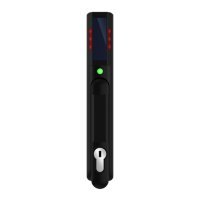INTELLIGENT PDU USER MANUAL
Section 5 – Daisy Chain Configuration
Daisy-Chain Overview
In daisy chain mode, up to (4) PDUs of the same SKU number, and on the same
Firmware version, can be connected via one IP address. This allows users to gather
information and data on all daisy-chained PDUs from the main PDU. The daisy chain
functionality reduces network cost for PDUs. For example, a standard network switch
used in a data center may contain 24 ports. Without using the daisy chain function, each
port would supply a network connection to one PDU. However, if using the daisy chain
features, a typical network switch with 24 ports can supply network connections for up
to 96 PDUs.
Note: When replacing a Daisy Chained PDU or Accessory, please ‘RESTART’ the
Primary (main) PDU1 controller to re-synchronize the daisy chained PDUs sequence.
This action will not disrupt operations (or outlet states) and can be completed remotely
via WebGUI, SNMP or CLI or physically by pressing and holding the reset button on the
primary controller for 10 seconds (but not more than 15 seconds).
Daisy-Chain Setup
1. After the initial PDU is configured (parent), connect an Ethernet cord from the
PDU Out port on the configured PDU to the PDU In/Serial port on the second
PDU in the daisy chain line.
2. Repeat step 2, connecting PDUs from the PDU Out port to the PDU In/Serial
port for up to 4 PDUs.
Note: The total length of the Ethernet cords connecting the PDUs must be less
than 15m (49 ft.).
3. Go to the Web interface (or management software) to manage and control the
PDUs in the daisy chain.
RNA (Redundant Network Access) Functionality
RNA allows secure access of PDU data and statistics on two separate, private
networks. RNA must be used with a redundant power delivery design including two rack
PDUs for each IT rack. PDUs used in RNA applications must be the same SKU/Part
Number. A maximum of (2) PDU can be used in the RNA convention. See the below
figure for a connection diagram when deploying RNA.

